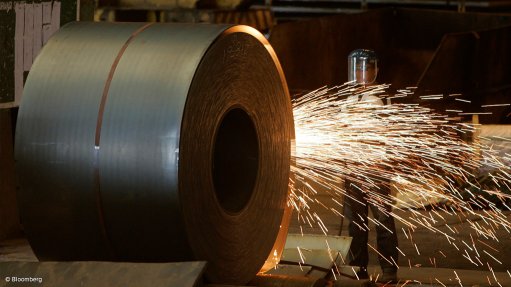Slurry pumps limit flooding risk in mines
The risk of flooding underground while mining is a reality and needs to be properly addressed by mining companies, warns South Africa-based submersible slurry pump manufacturer Hazleton Pumps.
“Standard submersible pumps are used to help prevent this from occuring but are limited in capacity due to the supply voltage, which is commonly 525 V, while only 350 kW power is available,” says Hazleton Pumps director Maureen Wehmeyer.
To pump high volumes using submersible pumps, the installed power needs to be about 1 200 kW and using a medium- voltage supply of 3.3 kV or 6.6 kV, which will result in drawing a far lower current than when using 525 V supply.
“In most cases, the length of supply cables is also a limitation when operating with a supply voltage of 525 V, owing to the voltage drop that occurs, which is the main reason the supply voltage must be 3.3 kV or 6.6 kV,” notes Wehmeyer, adding that, owing to the current being proportional to the voltage at 3.3 kV, the current will be 15.9% of the current at 525 V, allowing smaller cables to be used.
By installing switchgears above the flood level the high-volume, medium-voltage submersible pump can be started remotely from the surface, which cannot be done when using low-voltage equipment.
“When designing medium-voltage submersible pumps it is essential that the power supply is isolated before failure of the pump occurs, to limit the risk of electrifying the area,” she says.
Mechanical seals on submersible pumps are most likely to fail first, allowing fluid to enter motor housings and cause an electrical short on the motor winding.
“To detect the failure of mech- anical seals, seals operate in an oil-filled compartment. The oil used is nonconductive and lubricates seals, and assists in dissipating the heat from seal faces. Two seals are used to ensure reliabil- ity. The upper seal, which is directly above the lower seal, seals off the motor chamber, while the lower seal is mounted in the oil chamber,” notes Wehmeyer.
She adds that “when mechanical seals start failing, fluid enters the oil chamber, contaminating the oil and making it conductive. By installing a probe in the oil chamber the conductivity of the oil can be measured and the pump can be isolated if the oil is contaminated or conductive.”
Pump monitoring is a key requirement when using medium- voltage pumps to monitor the deterioration of key components such as the bearings, windings and seals. Further, the pump can be isolated before any of the key components fail.
“Temperature changes in components will indicate the extent of deterioration, which is why temperature probes are installed at the bearing and in the winding,” explains Wehmeyer, adding that should a rise in temperature on any of the components occur, the pump will be isolated automatically by the control circuit of the monitoring system, which is connected to the pump switchgear.
“The initial capital investment in procuring a high-volume, medium-voltage submersible pump is high, but the cost savings on power consumption, switchgear and cable installation costs make this method of pumping cost effective,” says Wehmeyer.
Comments
Press Office
Announcements
What's On
Subscribe to improve your user experience...
Option 1 (equivalent of R125 a month):
Receive a weekly copy of Creamer Media's Engineering News & Mining Weekly magazine
(print copy for those in South Africa and e-magazine for those outside of South Africa)
Receive daily email newsletters
Access to full search results
Access archive of magazine back copies
Access to Projects in Progress
Access to ONE Research Report of your choice in PDF format
Option 2 (equivalent of R375 a month):
All benefits from Option 1
PLUS
Access to Creamer Media's Research Channel Africa for ALL Research Reports, in PDF format, on various industrial and mining sectors
including Electricity; Water; Energy Transition; Hydrogen; Roads, Rail and Ports; Coal; Gold; Platinum; Battery Metals; etc.
Already a subscriber?
Forgotten your password?
Receive weekly copy of Creamer Media's Engineering News & Mining Weekly magazine (print copy for those in South Africa and e-magazine for those outside of South Africa)
➕
Recieve daily email newsletters
➕
Access to full search results
➕
Access archive of magazine back copies
➕
Access to Projects in Progress
➕
Access to ONE Research Report of your choice in PDF format
RESEARCH CHANNEL AFRICA
R4500 (equivalent of R375 a month)
SUBSCRIBEAll benefits from Option 1
➕
Access to Creamer Media's Research Channel Africa for ALL Research Reports on various industrial and mining sectors, in PDF format, including on:
Electricity
➕
Water
➕
Energy Transition
➕
Hydrogen
➕
Roads, Rail and Ports
➕
Coal
➕
Gold
➕
Platinum
➕
Battery Metals
➕
etc.
Receive all benefits from Option 1 or Option 2 delivered to numerous people at your company
➕
Multiple User names and Passwords for simultaneous log-ins
➕
Intranet integration access to all in your organisation

















